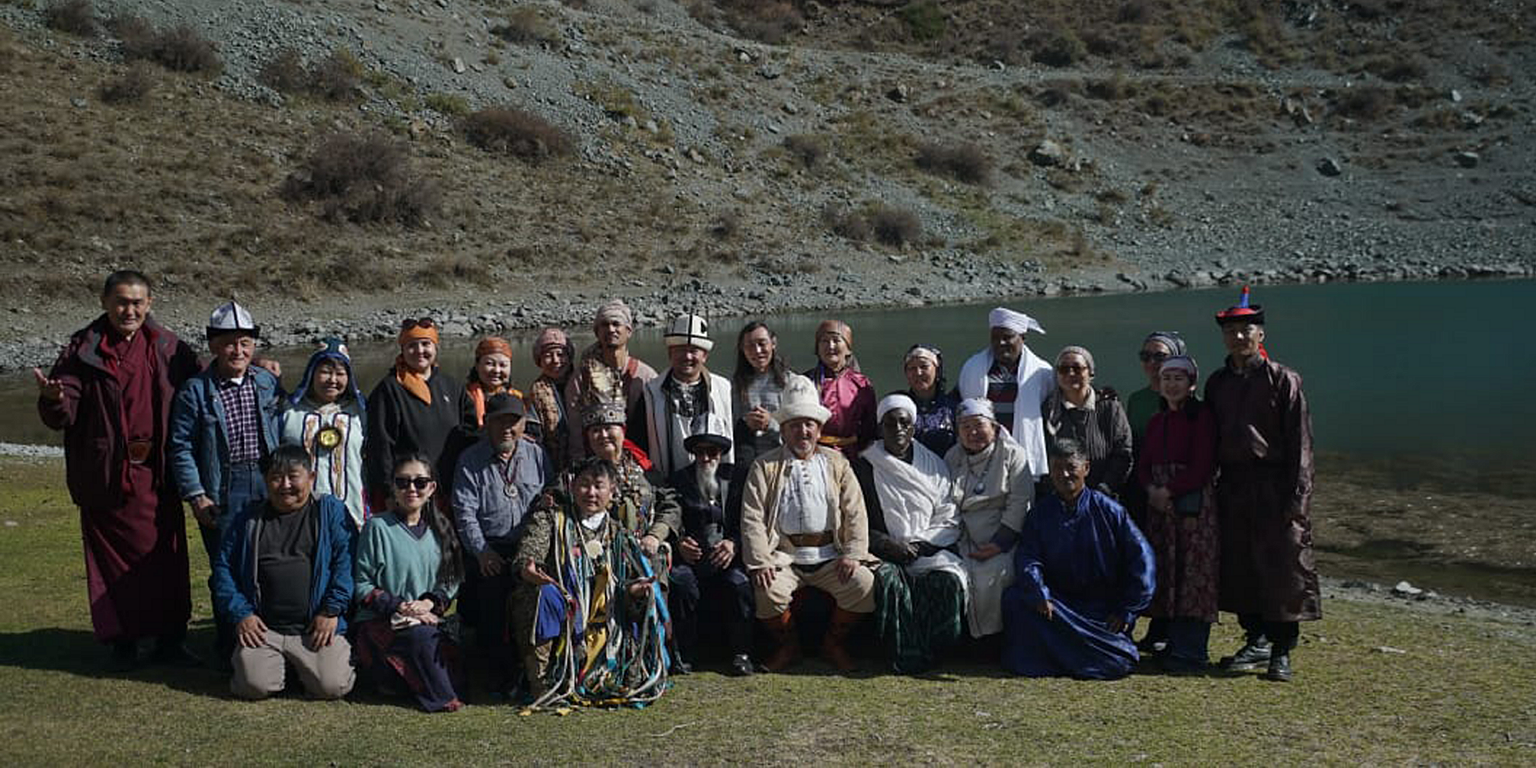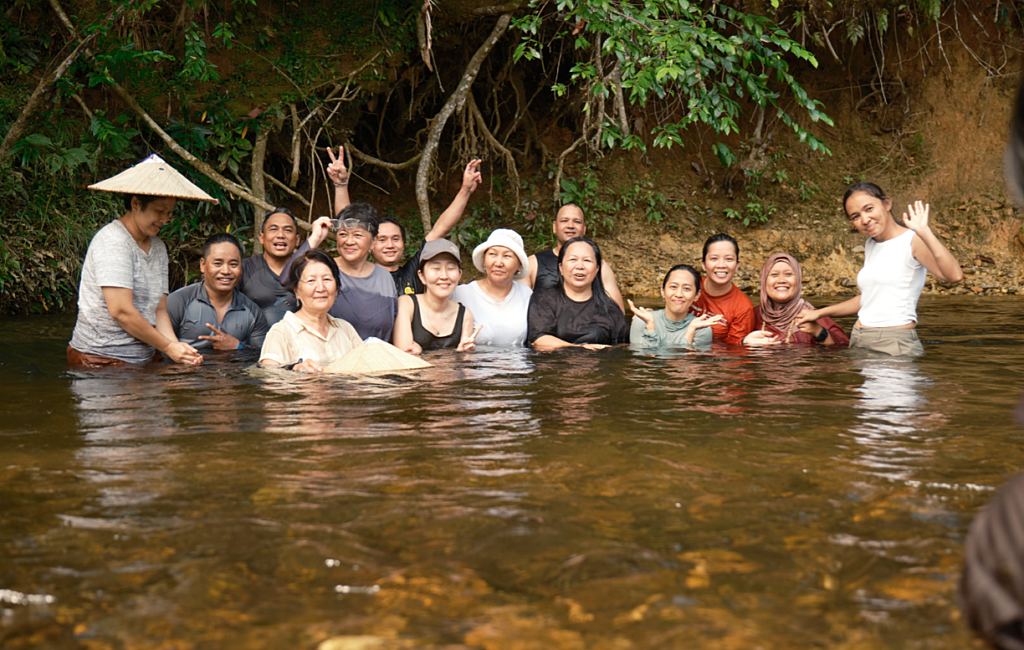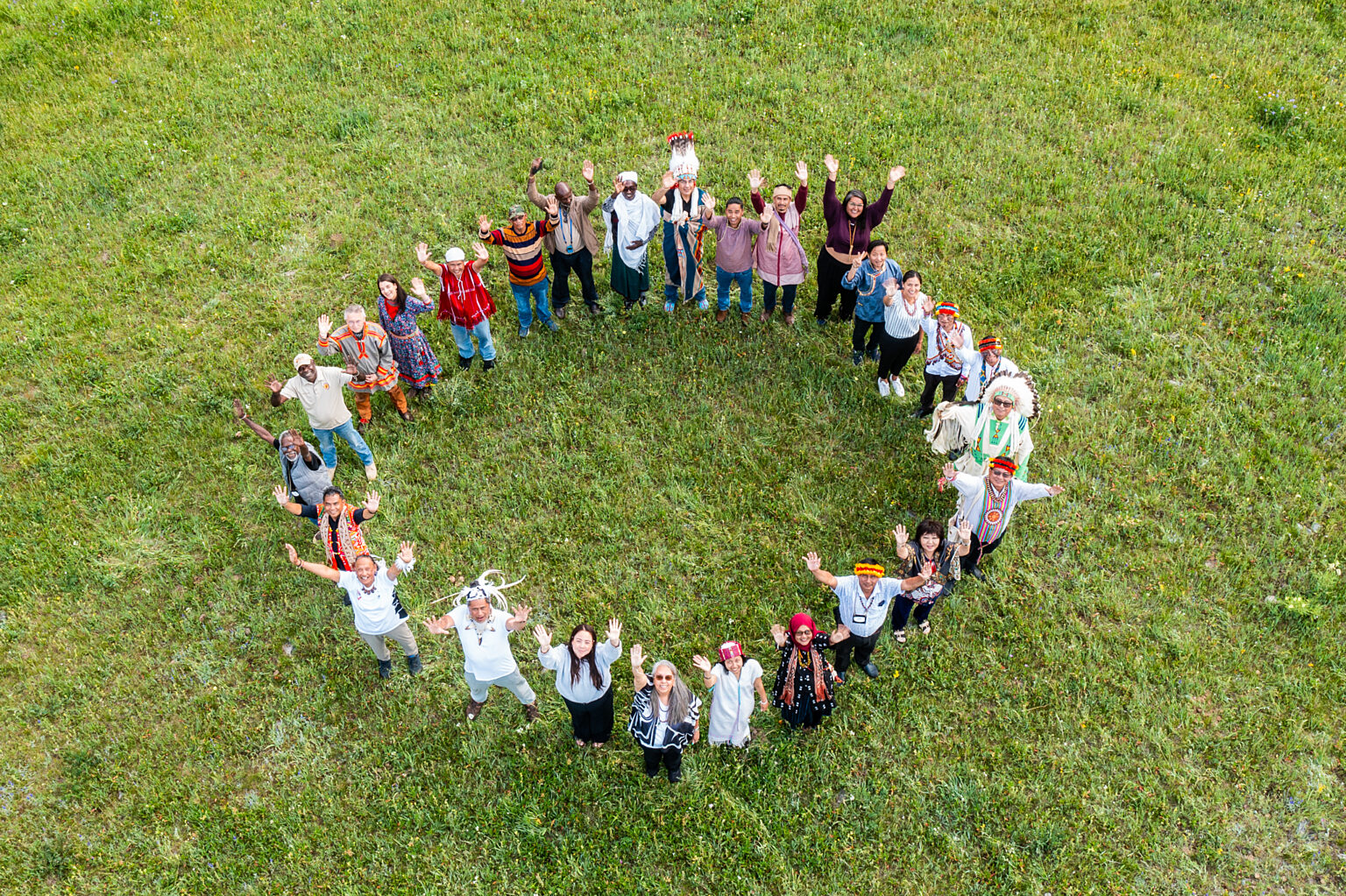The clear, cooling waters of the Sungai Utik River in Indonesia twist and bend through towering Ironwood and Sago trees, swimming below the resounding calls of Hornbills and Kites, and bringing food, medicine, and spiritual power to the vibrant forest and its human caretakers - the Dayak Iban people of Sungai Utik.
For centuries, the river has been the life-giving artery for local Indigenous Peoples referred to in Iban language as Darah, ‘our blood.’ On this warm afternoon, a contingent of Indigenous leaders from across central and southeast Asia, will spend four days exchanging knowledge, blessings and spiritual energy as part of a Regional Gathering of the Wayfinders Circle.
“The abundance of nature here is even greater than in Hin Lad Nai,” remarks Chaitawat “Tot” Chomti (Karen People of the Hin Lad Nai community in Northern Thailand), a beekeeper and climate activist. “They have smaller mountains and larger plains, resulting in greater abundance. [But] the kinds of trees are pretty much the same.”
Chomti and ten other international delegates have recently arrived from their home territories, traveling up to three days to gather at this storied river’s edge. He is joined by his Hin Lad Nai colleague Aphichai Khacha; byTsewang Bista and Ashoka Pariyar from the Lhoba Indigenous Community of Nepal and NEFIN (Nepal Federation of indigenous Nationalities); World Union of Indigenous Spiritual Practitioners (WUISP) representatives Altantsetseg Tsedendamba from Arga Bilig, Mongolia, and Kuluipa Akmatova from the Kushchu and Tashtanbek clans of the Kyrgyz People; from the Philippines, Valeree Nolasco and Luchie Maranan (Tagalog) of Nia Tero and Pawanka Fund, respectively; and from the Indonesian Indigenous organization AMAN (Aliansi Masyarakat Adat Nusantara), Feri Nur Octaviani (Javanese). Several interpreters and support staff are also assisting with this unique regionally focused Indigenous exchange.
This follows successful large-scale member gatherings in Achuar Territory in Ecuador in 2022, in Blackfeet Territory in the U.S. in 2023, and in Mongolia in 2024. Wayfinders Circle leadership decided that a series of smaller, in-person exchanges focused on particular regions would be the most effective way of furthering their mission. This gathering in Sungai Utik is the first of these exchanges.
Community-Building: Sharing Experiences and Struggles
When they first arrived two days earlier, the visiting Wayfinders were greeted by families and elders of the community and participated in a traditional ceremony called Ngalu ka Temuai. Each visitor climbs a small set of wooden stairs to the massive community longhouse, each of the stairways capped with a carving honoring an ancestor. They are then Greeted with carefully woven traditional scarves and a glass of ‘Tuak’ or rice wine to pour over the ground to get rid any negative energy. Following the ceremony, each Wayfinder was then partnered with a host family in the longhouse to encourage closer communication and immersion in Dayak Iban lifeways.
The longhouse was built in the early 1970s and houses all of the roughly 300 people in separate family apartments called Bilik. It’s an impressive structure that facilitates the social, ceremonial and governance functions of the community.
One of the main priorities of the gathering was to learn about each community’s recent past and how they have dealt with outside pressures. In an official welcoming and orientation session, Sungai Utik elders spoke of the challenges they faced in the early 1970s when commercial and government interests first tried to take over their forest.
Elder Igo, who was only 17 at the time, explained, “We resisted the arrival and entry of a private company– they were not welcome here. They stole the wealth of the land without our consent.”
“We experienced discrimination. Religion was forced on us,” remembered Elder Raymundus. “In response, we fought to defend our territory with mapping as evidence presented to the government. The map is our own weapon.”
Raymundus and other elders described how, as young adults, they and the entire community were involved in carefully mapping their territory, noting bodies of water, important trees, bird and wildlife ranges, as well as sacred sites and places of agricultural importance. These efforts have been key in advocating for their land base and their territorial rights. They also helped enable partnerships with organizations like AMAN to maintain their systems of governance and self-determination – which they still struggle to preserve today amid rampant deforestation and mining activity all around their territory.
The visiting Wayfinders in turn shared the ways their territories have been threatened and the ongoing challenges they face in obtaining true self-governance and dealing with state and commercial powers in each of their countries. The Lhoba guests spoke of water shortages, Chinese and Indian government incursions to search for uranium and the difficulties of maintaining cultural and spiritual connections as more youth were leaving for large cities. Participants from Hin Lad Nai decried the lack of food sovereignty in their home territory and their struggle against outside agricultural influences pushing them toward monocropping to maximize short term profits.
In the face of these challenges back home, the participants drew inspiration and important lessons from the stories that can help their own land protection efforts. “This is my first visit to a foreign community with forests,” related Tot. “I learned a lot about the protection of the forest which I shall share to my community.”
Forging New Connections Through Fire
The Wayfinders woke early the following day to travel to an agricultural site and join in a key land-management practice – controlled burning.
Deep in the forest, on a mountainside clearing surrounded by healthy tree cover, they donned knee-high boots, wide-brimmed farmer’s hats and machetes. Led by Sungai Utik agriculturalists, they helped to clear a large swath of crop lands used for rotating rice, corn, cassava and sweet potatoes. Wayfinders chopped and raked as they talked with the local farmers, learning about the unique adat laws that govern the forest and forbid commercial exploitation of any kind, as well as the specialized crop rotation strategy that has allowed this land and its people to thrive. On every plot, farmers plant a different food for four consecutive growing seasons, and then leave the land to regenerate for up to 12 years before it can be used again, ensuring the soil’s richness is maintained and the surrounding forests keep their biodiversity.
The team then set small fires to the remaining undergrowth, clearing the land for cultivation and infusing the soil with nutrients. Participants stayed until all the fires had burned out. Cultivation work could only begin 1-2 days later when the soil would be ready.
“This meeting is so different from other meetings where it’s all talking,” remarked Tsedendamba, the Mongolian elder from WUISP. “I am so grateful because we became part of the family.”
Tsewang Bista of the Lhoba Indigenous Community added, “Making the firebreak is also a new experience for me, firewood is expensive in Mustang. I saw the people’s unity in every aspect, and there is respect for the elements and the elders.”
Following the rewarding physical work, the Wayfinders connected with the nearby river, swimming, playing and splashing as its spirit rejuvenated their hearts and bodies before guiding them back to the longhouse via canoes piloted by expert Sungai Utik paddlers.
Lessons From Dayak Iban Youth
Perhaps the most emotionally involved parts of the exchange were the deep connections with the youth of the community, a key priority for the Wayfinders Circle. Visiting Wayfinders took an in-depth tour of the community’s Indigenous School, opened in 2021, and spoke with students, teachers and the energetic Principal, Kristiana Banang.
“They are taught about their identity, their awareness of being Dayak from the Long House,” noted Principal Banang. “We inspire the children to appreciate living in the village. We teach arts, culture, crafts, farming, the history and rituals.”
Participants noted the positive energy on the children’s faces as they learned about their own history and culture, their traditions and Indigenous wisdom, as well as their sustainable practices.
When one of the Wayfinders asked about how they avoid the powerful influences of technology such as smartphones and social media, the Principal and other elders remarked, “We cannot ignore technology. We use them wisely, getting information to enrich and maintain traditions, and they use social media to post about our cultural activities ... giving the space to the children to divert them from gadgets, so they have deep relations to their roots, not dependent on others, and they become self-sufficient in many aspects.”
And there is early evidence the efforts at the Indigenous School are working to keep youth involved with the community even when they move away for education, advocacy work or other opportunities. Yessi, Principal Banang’s daughter, is currently studying in the distant town of Bogor, near Indonesia’s sprawling capital of Jakarta, but was able to return to the community to do her field work.
“There are youth in the city, but that doesn’t mean we left our tradition,” explained Yessi. “We have unique stories of life, we are special because we have the forests.”
Internationally recognized filmmaker Kynan Tegar, a student at University in Jakarta who grew up both in Sungai Utik and in nearby cities (and who directed the Award-winning Wayfinders Circle film Indai Apai Darah) sees children as perhaps the most important and powerful aspect of Sungai Utik life.
“Being Indigenous is varied, diverse, and fluid. There is so much solidarity and shared histories. There are stories buried that must be told,” he said. “The youth have a future in this community. We have to find what future is possible for us.”
‘We Became a Part of This Community’
At a sacred site overlooking the gently flowing Sungai Utik River the participants took time to reflect on the close regional connections that had been forged over the many hours of talking, working, thinking and sharing.
“I felt at home,” remarked Apichai of Hin Lad Nai. “I have captured the memory to bring back and share.”
Andri from AMAN shared similar feelings: “I go to the river every morning. There is very positive energy and we share with others our indigenous practices. This exchange is a dot that connects us at the international level.”
“It feels like being at home, like coming back home,” Tot from Hin Lad Nai agreed. “As if we are brothers and sisters. […] Both of us are in harmony and connected with nature. It feels like a kindred relationship.”
All of the Wayfinders invited the group to join them in their home territories to host a similar learning experience in the future.
The gathering in Dayak Iban lands confirmed the strong belief of Wayfinders Circle members and conveners that these face-to-face experiences are critical to building the Circle collectively as a movement of Indigenous Peoples living across diverse ecosystems, who share guardianship of their territories, a deep commitment to self-governance and the intergenerational transmission of knowledge. Through these exchanges of ideas, spiritual energy and physical contact with each other and nature, the Wayfinders Circle honors the essence of global Indigenous movements, strengthening bonds and mutual support step by step and in their own time.
Future Wayfinders Circle Regional Gatherings are taking place later in 2025 at the Sacred Fire Ceremony in Mongolia, hosted by WUISP, and in the Mojave Desert, in the U.S., hosted by the Native American Land Conservancy.
“This is a tribute to harmony,” said Akmatova, a member of WUISP from Kyrgyzstan. “We became a part of this community. We realized how organically and naturally it all connects. […] The whole world should pay attention to how we can impact global issues by using local solutions.”
Before the Wayfinders began their long journey home, Longhouse Spiritual Leader Apai Janggut shared the sobering reality that the community is now engaged in efforts to fight increased gold mining upriver that threatens the very waters that bring life to their forest home. But he noted that the profound exchange with their fellow Wayfinders had reminded the people of Sungai Utik of the enduring strength that has kept the community and the forest thriving.
He said, “We have unity and solidarity that cannot be broken. For us, The Land is our Mother. Forest is our Father. And river is our blood. So we must protect our customary territories.”



